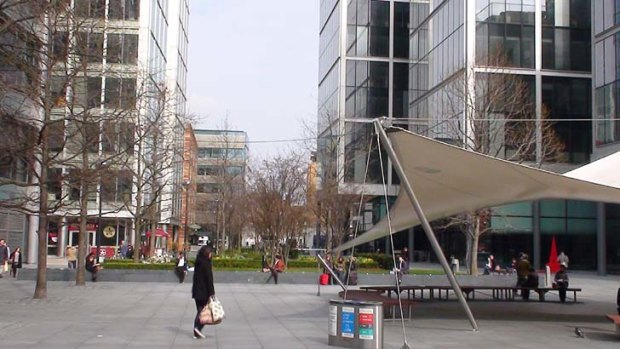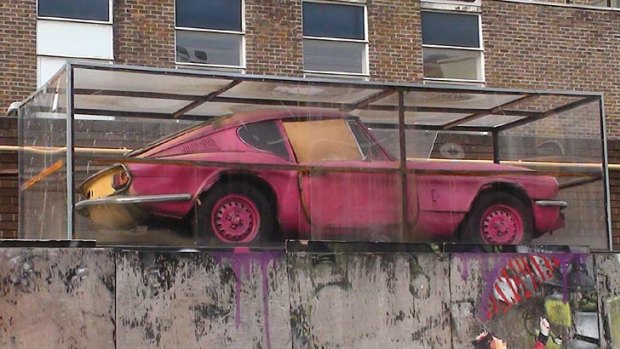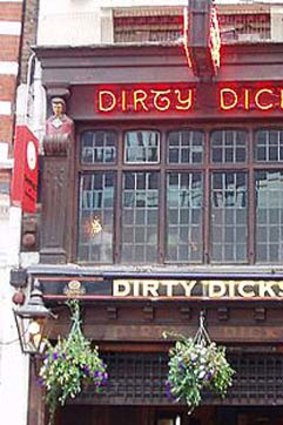This was published 12 years ago
From Dirty Dick to Olympic: London's rough edge transformed
By Christine D'Mello

Shopping mecca ... East End's Spitalfields Square bears no resemblance to its past
A nondescript London neighbourhood is rapidly transforming itself into the cultural hub for the 2012 Olympics.
Not long ago it was the unfashionable end of town. The East End of the English capital was more associated with Jack the Ripper, poverty and migrants than funky fashion boutiques and trendy cafes.
The brand new construction and refreshing green of Olympic Park signifies the demise of the long-held perception that this is the poor cousin of London suburbia.

Legendary street artist Banksy's work adorns the East End
Our introduction to the East End of London begins in the lobby of the Andaz Hotel. Hedley, our guide from Insider London tours, wastes no time telling us about the eco-friendly efforts of the Andaz - the toilets are akin to the waterless loos on planes and the front desk is paperless.
Then he launches into a history of the East End.
But we are not here for a history lesson, interesting as it may be - this used to be the poor end of town, it was overcrowded, there was a mental hospital, it was a slum area, it attracted migrants. We are here to find out what this part of town has to offer come July next year.

Pub with many tales ... Dirty Dicks
And we are not disappointed.
There are stories to tell - for instance, the Dirty Dick's pub on Bishopsgate. The pub takes its name from a dirty warehouse.
The story goes that a merchant in the area, believed to be named Dick, was getting ready for his marriage, only to be told his bride-to-be had passed away.
Following her death he refused to change his wedding clothes or clean up. Hence the name Dirty Dick.
This pub was originally called the Old Jerusalem, but the owners transferred the warehouse name to the watering hole.
A few doors away is the Ten Bells pub, which some of the victims of the notorious serial killer Jack the Ripper are believed to have frequented. And the alleys behind the pub are where he conducted his sordid business.
So we see the past and present - as in much of London - elbowing for space and recognition. We are what we are because of history, and East London is no exception.
The past has been embraced and built upon, and its essence preserved in spirit.
Take Spitalfields Square. The shops here are boutiques. Very few major chains have been allowed entry to ply their trade. As Hedley put it: "You don't want to be reverse-mugged by a mannequin."
There is a relaxed feel to the place with cafes lining the sides of the square. People sit in the open air, sipping tea or coffee, reading the day's news via a rather old-fashioned medium, the newspaper.
The Old Spitalfields Market is a few steps away. Once a place to hawk fruit and vegetables, today you can buy books, beads and bangles here. It would take the better part of the morning to get through the stalls to find hidden treasures - T-shirts, leggings, woollen shawls, bags, leather goods and colourful trinkets. Stalls are on rotation. It could be fashion and art on one day, antiques on another. No wonder it's been voted `Best London Market' twice.
The multicultural nature of the market is no surprise, after all, this is the area of London that attracted migrants: French Protestant Huguenots in the 17th century, followed by the Irish, the Ashkenazi Jews and, more recently, the Bangladeshi community in the 1960s.
And that is evident as you walk down to Brick Lane - the street sign is in both English and Bengali. `London's curry capital' is choc-a-bloc with people. Cars try to muscle their way past the crowds, but only up to a point. People play chess and carrom along the sides of the street, as music blares out in a carnival atmosphere.
Stalls line the side of the street selling almost anything.
The aroma of different cuisines wafts gently over the heads of the masses, creating havoc with the senses.
The area's street art is striking - a huge black-and-white stork worked into the side of a building, a train driver's view as he comes out of a tunnel, the late Princess Diana. In fact, there are special tours that take in the iconic street art of East London.
One notable is the pink car by the mysterious street artist Banksy that sits in the square at the Old Truman Brewery. In the square you will find a treasure trove of street art. This square also houses fashion and music shops, hairdressers, street fashion culture, and the StolenSpace gallery.
Tucked in one corner of the square, the gallery has a green hut sitting in the centre of its showroom - this gives you an insight into the workspace of a street artist. And the door next to the gallery entrance is covered with graffiti and tags. Street artists use this door as a sign-in book.
Art seems to permeate through much of East London. As we meander down the quiet roads from Stratford Station, which will be the gateway to the main Olympic Park, we pass old buildings and warehouses.
As we make our way towards the centrepiece Olympic Stadium in the setting light, the hustle and bustle of London seems a world away. After a turn here and a pause there, and a walk by a waterway hosting boat houses, we come upon a path for pedestrians and cycles.
To the left is a warehouse that has been converted into a residence with a million-pound view of the main Olympic stadium.
Olympic Park is a beehive of activity as would be expected. The hum of coaches can be heard in the fading light. One can only imagine the buzz of activity in another 15 months as it hosts the athletics, aquatics, cycling, hockey and basketball events, and the athletes' village.
But to those wanting respite from the Games bustle, there's the West End, the enduring heart of theatre. The Phantom of the Opera and The Mousetrap are two long-running notables.
Carry a heavy wallet when you head down to the shopping district, though savvy shoppers can pick up bargains at the trendy boutiques on Oxford Street, Regent Street and Piccadilly Circus.
Weary travellers can revitalise themselves in the plush environs of the Langham's Chuan Spa near Regent Street.
Visitors who don't have tickets to the stadiums can catch some action for free - the marathon goes past Buckingham Palace, Admiralty Arch, St Paul's Cathedral and the Houses of Parliament. Hyde Park will host the triathlon and road cycling.
Interestingly, London will have its own beach during the Games with the beach volleyball being held in the shadow of the prime minister's residence in Downing Street.
There are plans to have music, theatre and cultural events in Hyde Park during the northern summer in 2012.
Giant screens will be set up at live sites across London - Jubilee Gardens, Victoria Park, Potters Field and Hyde Park.
The World Shakespeare Festival will run from April 23 to September 9 next year. All the plays of the Bard will be performed in different languages in that one season, a first.
Meanwhile the London 2012 Festival will be held from June 21 to September 9 in which leading world artists will come together in one big festival through dance, music, theatre, the visual arts, film and digital renovation.
Dickens 2012 is a year-long event to mark the bicentenary of the birth of noted literary figure Charles Dickens.
British Design 1948-2012 at the Victoria and Albert Museum will showcase 60 years of British creative talent.
And there's the annual Notting Hill carnival, held in August.
Plus there are the iconic sights - the Tower of London, the Tower Bridge, Buckingham Palace, Royal Mews, Westminster Abbey, Big Ben, the Houses of Parliament, Madame Tussaud's, a cruise on the Thames, Leicester Square and Covent Garden.
No visit to London is complete without a spin on the London Eye, a Ferris wheel that slows down time as you take in the panoramic landscape.
You can almost hear London calling.
The writer was a guest of VisitBritain, The Langham hotel and Virgin Atlantic.
FAST FACTS
GETTING THERE
Virgin Atlantic flies once daily from Sydney to London via Hong Kong. Details: www.virgin-atlantic.com
STAYING THERE
The Langham hotel has rooms ranging from STG199 ($A310) for a Classic Double to STG8000 ($A12,450) for the Infinity Suite per night. Details: www.london.langhamhotels.co.uk
For more info go to www.visitbritain.com or www.visitlondon.com
AAP
Sign up for the Traveller Deals newsletter
Get exclusive travel deals delivered straight to your inbox. Sign up now.